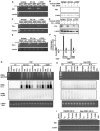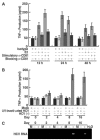Hepatitis C virus E2-CD81 interaction induces hypermutation of the immunoglobulin gene in B cells
- PMID: 15956553
- PMCID: PMC1143751
- DOI: 10.1128/JVI.79.13.8079-8089.2005
Hepatitis C virus E2-CD81 interaction induces hypermutation of the immunoglobulin gene in B cells
Abstract
Hepatitis C virus (HCV) is one of the leading causes of chronic liver diseases and B-lymphocyte proliferative disorders, including mixed cryoglobulinemia and B-cell lymphoma. It has been suggested that HCV infects human cells through the interaction of its envelope glycoprotein E2 with a tetraspanin molecule CD81, the putative viral receptor. Here, we show that the engagement of B cells by purified E2 induced double-strand DNA breaks specifically in the variable region of immunoglobulin (V(H)) gene locus, leading to hypermutation in the V(H) genes of B cells. Other gene loci were not affected. Preincubation with the anti-CD81 monoclonal antibody blocked this effect. E2-CD81 interaction on B cells triggered the enhanced expression of activation-induced cytidine deaminase (AID) and also stimulated the production of tumor necrosis factor alpha. Knockdown of AID by the specific small interfering RNA blocked the E2-induced double-strand DNA breaks and hypermutation of the V(H) gene. These findings suggest that HCV infection, through E2-CD81 interaction, may modulate host's innate or adaptive immune response by activation of AID and hypermutation of immunoglobulin gene in B cells, leading to HCV-associated B-cell lymphoproliferative diseases.
Figures






Similar articles
-
Hepatitis C virus (HCV)-induced immunoglobulin hypermutation reduces the affinity and neutralizing activities of antibodies against HCV envelope protein.J Virol. 2008 Jul;82(13):6711-20. doi: 10.1128/JVI.02582-07. Epub 2008 Apr 16. J Virol. 2008. PMID: 18417597 Free PMC article.
-
Hepatitis C virus protects human B lymphocytes from Fas-mediated apoptosis via E2-CD81 engagement.PLoS One. 2011 Apr 19;6(4):e18933. doi: 10.1371/journal.pone.0018933. PLoS One. 2011. PMID: 21526201 Free PMC article.
-
Pre-stimulation of CD81 expression by resting B cells increases proliferation following EBV infection, but the overexpression of CD81 induces the apoptosis of EBV-transformed B cells.Int J Mol Med. 2015 Dec;36(6):1464-78. doi: 10.3892/ijmm.2015.2372. Epub 2015 Oct 13. Int J Mol Med. 2015. PMID: 26498453 Free PMC article.
-
Hepatitis C virus entry and the tetraspanin CD81.Biochem Soc Trans. 2011 Apr;39(2):532-6. doi: 10.1042/BST0390532. Biochem Soc Trans. 2011. PMID: 21428934 Review.
-
The rheumatoid factor response in the etiology of mixed cryoglobulins associated with hepatitis C virus infection.Ann Med Interne (Paris). 2000 Feb;151(1):30-40. Ann Med Interne (Paris). 2000. PMID: 10761560 Review.
Cited by
-
Second malignant neoplasms in lymphomas, secondary lymphomas and lymphomas in metabolic disorders/diseases.Cell Biosci. 2022 Mar 12;12(1):30. doi: 10.1186/s13578-022-00763-0. Cell Biosci. 2022. PMID: 35279210 Free PMC article. Review.
-
A comparative study of different antiviral treatment protocols in HCV related cryoglobulinemic vasculitis.Sci Rep. 2024 May 23;14(1):11840. doi: 10.1038/s41598-024-60490-z. Sci Rep. 2024. PMID: 38782988 Free PMC article.
-
Hepatitis C and non-Hodgkin lymphoma among 4784 cases and 6269 controls from the International Lymphoma Epidemiology Consortium.Clin Gastroenterol Hepatol. 2008 Apr;6(4):451-8. doi: 10.1016/j.cgh.2008.02.011. Clin Gastroenterol Hepatol. 2008. PMID: 18387498 Free PMC article.
-
Differential Expression of CD43, CD81, and CD200 in Classic Versus Variant Hairy Cell Leukemia.Cytometry B Clin Cytom. 2019 Jul;96(4):275-282. doi: 10.1002/cyto.b.21785. Epub 2019 May 11. Cytometry B Clin Cytom. 2019. PMID: 31077558 Free PMC article.
-
A patient with chronic hepatitis C and a pancreatic mass in endoscopic ultrasound.Case Rep Gastroenterol. 2012 May;6(2):387-93. doi: 10.1159/000339693. Epub 2012 Jun 19. Case Rep Gastroenterol. 2012. PMID: 22855657 Free PMC article.
References
-
- Albesiano, E., B. T. Messmer, R. N. Damle, S. L. Allen, K. R. Rai, and N. Chiorazzi. 2003. Activation-induced cytidine deaminase in chronic lymphocytic leukemia B cells: expression as multiple forms in a dynamic, variably sized fraction of the clone. Blood 102:3333-3339. - PubMed
-
- Altomonte, M., R. Montagner, C. Pucillo, and M. Maio. 1996. Triggering of target of an antiproliferative antibody-1 (TAPA-1/CD81) up-regulates the release of tumour necrosis factor-alpha by the EBV-B lymphoblastoid cell line JY. Scand. J. Immunol. 43:367-373. - PubMed
-
- Bross, L., Y. Fukita, F. McBlane, C. Dómollière, K. Rajewsky, and H. Jacobs. 2000. DNA double-strand breaks in immunoglobulin genes undergoing somatic hypermutation. Immunity 13:589-597. - PubMed
-
- Carter, R. H., and D. T. Fearon. 1992. CD19: lowering the threshold for antigen receptor stimulation of B lymphocytes. Science 256:105-107. - PubMed
Publication types
MeSH terms
Substances
Grants and funding
LinkOut - more resources
Full Text Sources
Other Literature Sources

